Facts about Niagara Falls
Niagara Falls Facts and Photos for Kids
Posted by Admin / in Science Facts
There are many interesting facts about Niagara Falls. In terms of the amount of water flowing over a major waterfall, Niagara Falls is one of the largest in the world (3rd largest). It is considered one of the natural wonders of the world and attracts millions of visitors each year. Niagara Falls is actually two waterfalls including the American Falls and the larger Horseshoe Falls. Niagara Falls is the result of water flowing from Lake Erie to Lake Ontario. Looking at the larger view of water flow, waters from Lake Superior, Michigan, Huron and Lake Erie all flow over the falls into Lake Ontario. Viewing of the falls is possible from both the United States and Canada sides of the Niagara River. The State of New York operates the parks along the American viewing side. The Canadian government operates viewing areas along the Canada side.
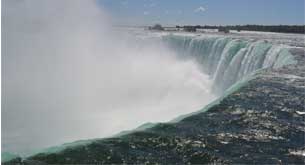
Niagara's Horseshoe Falls Looking Upstream from the Canadian Side
Niagra Falls Facts
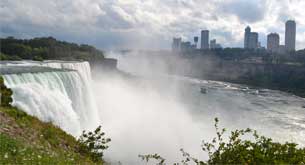
American Falls from the American Side
Niagara Falls is an important resource for both Canada and the United States. Since four of the five great lakes drain to the Niagara River, approximately 28 percent of the world's surface fresh water supply flows over Niagara Falls. This area has access to one of the highest amounts of drinking water on Earth. Not only is the water used for drinking water, but also for power. In the early 1900s the United States and Canada both started diverting water from the falls to produce hydroelectric power.
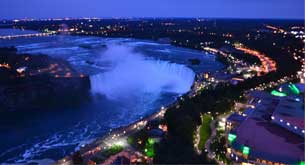
Niagara Falls at Night from Skylon Tower
WATER FACTS ABOUT NIAGARA FALLS
-
More than 44 million gallons of water travels over the Horseshoe Falls in Niagara every minute during peak flow.
-
About 90 percent of total water flows over the Horseshoe Falls and 10 percent flows over the American Falls.
-
Approximately 28 percent of the world's surface fresh water flows over Niagara Falls.
-
Water from Lake Superior, Michigan, Huron and Lake Erie flow over Niagara Falls through the Niagara River into Lake Ontario.
-
In terms of water flow, Niagara Falls is the third largest in the world.
-
The Niagara River is 150 feet deep at the bottom of the Horseshoe Falls.
-
Water flowing over Niagara Falls is enough to provide water to 55 million people each minute.
Fun Facts About Niagara Falls
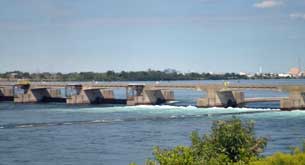
Hydroelectric Power Water Gate Upstream of Horseshoe Falls
Niagara Falls is a popular tourist location. Over the years the falls have been used not only to lure people to see the wonder of the falls, but water from the falls was used to make electricity. People have known for a long time that water is useful as a power source. Watermills have been used for many years to help people do work. In the late 1800s Nikola Tesla and George Westinghouse took this idea to a new level. In 1896 the two were responsible for successfully transmitting electricity from Niagara Falls all the way to Buffalo, New York. Electricity was transferred by a new process called alternating current (AC). An alternating current was first dreamed of by Tesla when he was only 9 years old. The alternating current allowed transmission of power over much longer distances than direct current (DC) allowed.
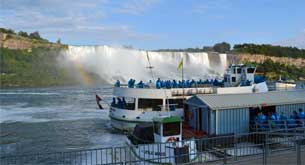
People Boarding the Maid of the Mist on the Canada Side
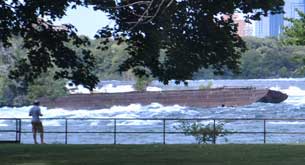
Boat Stuck Above Niagara Falls
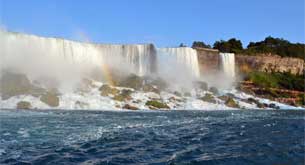
Rainbow in Front of the American Falls at Niagara Falls
FUN FACTS ABOUT NIAGARA FALLS
-
In 1896, hydroelectric power produced at Niagara Falls was transmitted to Buffalo, NY. This was the first long distance transmission of alternating current power (AC power) in the world. A statue of Nikola Tesla, the person who thought of AC power, is located in New York's Niagara Falls State Park.
-
Niagara Falls is a major electric producer for Western New York and Ontario.
-
Both the American Falls and Horseshoe Falls have tunnel systems under the falls that allow tourists to view the falls up-close.
-
The Maid of the Mist is a boat that takes tourists up-close to Niagara Falls. It has carried tourists since 1846, making it one of the oldest tourist attractions in North America.
-
The Maid of the Mist is expected to carry its last passenger from the Canada side in 2013. Rights for passenger boat passage from Canada were sold by the Canadian government to another company.
-
14 people have tried going over the falls in a barrel. 9 people survived the trip. The 5 people who did not survive, actually suffocated in the barrel (many were stuck at the top of the falls).
-
The first person to go over the falls in a barrel and survive was a 63 year old school teacher named Annie Taylor from Michigan.
-
In 1963 a 7 year old boy fell over his family boat upstream of the falls and survived the fall wearing only a life jacket. The Maid of the Mist boat picked him up in the Niagara River below the falls.
-
There is a large platform boat stuck in the Niagara River upstream from the Horseshoe Falls. It has been stuck since 1918. It was expected to break free 10 years ago, but remains stuck.
-
Viewing from the American side is typically much more windy than the Canadian side. The force of the water from Horseshoe falls is responsible for the air pressure felt on the American side.
-
Rainbows are very frequently viewed on a sunny day near Niagara Falls. Sunlight passing through mist from the falls creates this dramatic effect.
